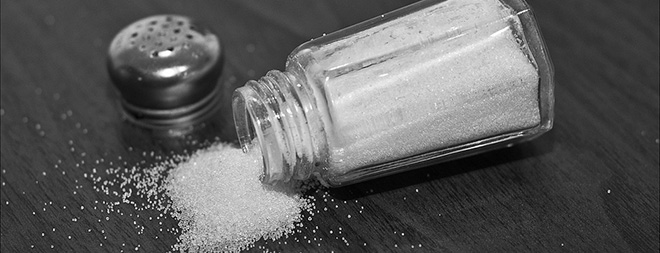Common Salt Could Help Make Cheaper Electronics

Image credits: Shardayy Photography via Flickr
(Inside Science) -- The same salt that adds flavor to your food could also make your iPad battery cost much less and last twice as long.
Common lithium-ion batteries – used in laptops, tablets and electric cars – use graphite to store the charge after the battery has been unplugged from the charger.
To make batteries that last twice as long, scientists have tried switching from graphite to silicon, due to its ten-times-larger storage capacity. Silicon nanostructures might be even better. They are made up of silicon particles at a much, much smaller size and have the same storage capacity as regular silicon, but don’t break down as easily.
These nanostructures are made by mixing silica – the material found in sand or clay – with hot magnesium vapor in a process called a “magnesiothermic reduction.” Silica contains silicon atoms paired with two oxygen atoms each. When silica reacts with magnesium, it gives up the oxygen and forms nano-sized silicon.
A group of Oregon State University researchers has found that adding common salt to the reaction mix increases the yield by three times and could greatly reduce the cost of making these nanostructures.
The snag
In earlier versions of the process, the hot magnesium vapor would flow through a long tube towards the silica. However, due to the distance between the two, only the portions of silica closest to the vapor would react, leaving a large pile of untouched silica. This made any sort of mass production expensive and “almost impossible,” said David Xiulei Ji, a materials scientist at Oregon State University in Corvallis.
To fix this problem, scientists tried mixing the magnesium with silica directly. The yield improved, but the excessive heat generated drove the temperature up to more than 3,000 degrees Fahrenheit, destroying most of the nanostructures as a result. The excess heat also makes the surviving nanostructures clump together.
“No silicon nanostructure can survive that temperature,” Ji said.
Salt as the savior
While exploring different ways to quickly remove the excess heat, the researchers tried using salts, particularly sodium chloride – the same salt found on your kitchen table.
The concept was simple: common salt has a high melting point, close to 1,500 degrees Fahrenheit. It can absorb heat at very high temperatures, and it is cheap and abundant. Plus, once the reaction is complete, the salt can be washed away with water. Evaporating away the water can then recover the salt for the next reaction cycle.
“That’s the beauty of this approach. Even though you use 10 grams of salt [for every gram of silica], you don’t waste any of it,” Ji said.
Their silica came from an inexpensive, abundant source called diatomaceous earth, which costs about $20 a bucket.
To be used commercially, nanostructures need to be mass-produced at a low cost. Attempts made so far have yielded extremely tiny quantities, Ji said. The new method has the potential to make much larger quantities, on the scale of kilograms, “although we haven’t demonstrated that yet,” he explained.
The researchers used the improved technique to make nanostructures containing a mix of silicon and germanium that could be used in batteries and semiconductors. By using salt to conduct heat away, the yield of nanostructures increased.
“In science, many problems can be solved by simple solutions,” Ji said.
Batteries are only one of those potential applications; silicon nanostructures are also being tested by other researchers to build solar cells, flexible LED sensors and drug-delivery systems for treating cancer.
The study was published in Nature Scientific Reports.
If any readers have heard of other clever ways to make nanostructures more efficiently, please share them with us in the comments.
